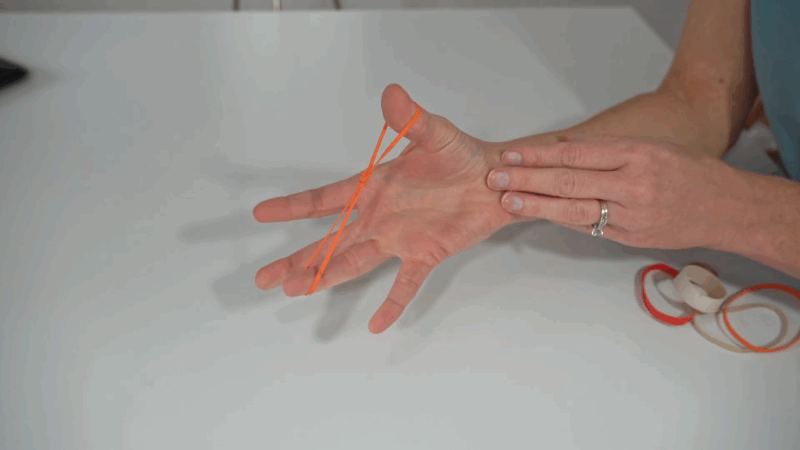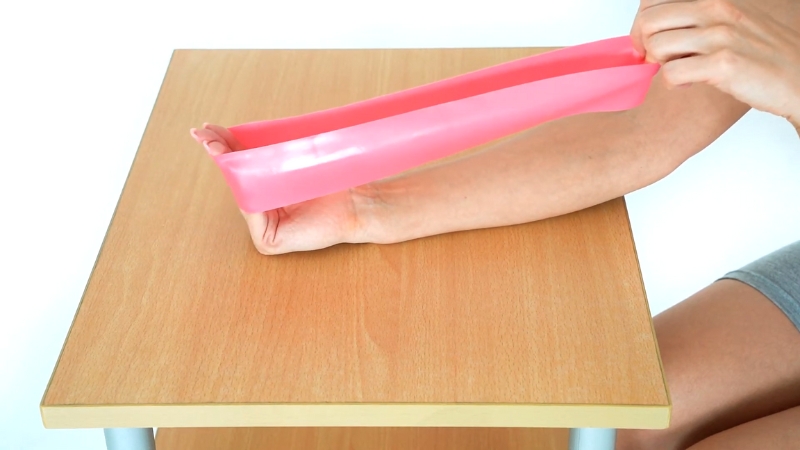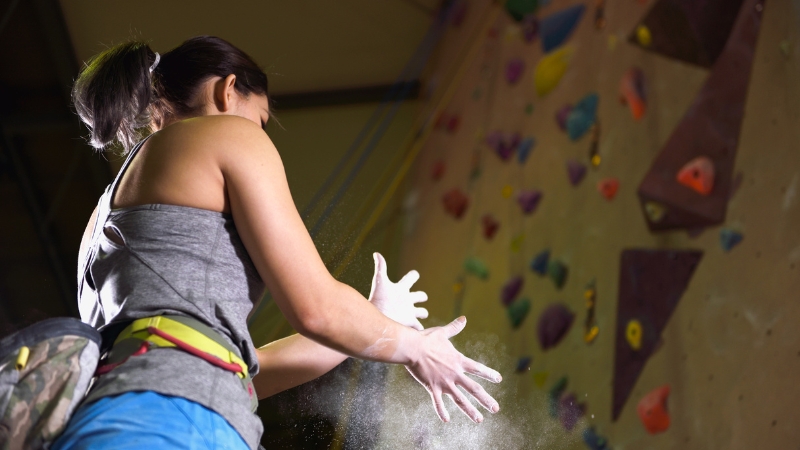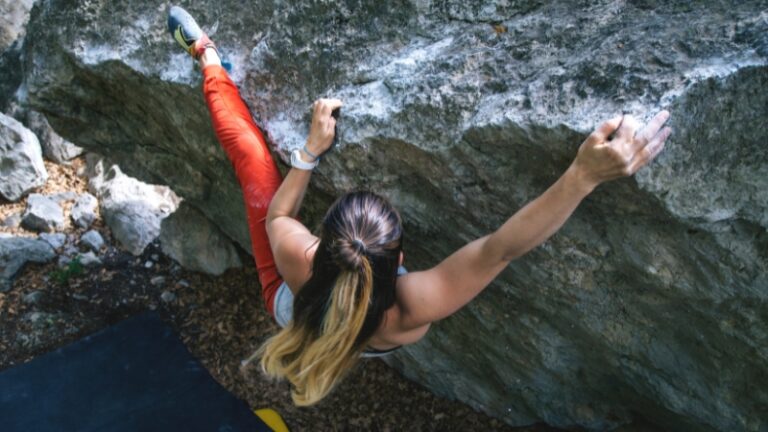If you’ve ever found yourself slipping off a hold despite perfect footwork and body positioning, chances are your grip strength—not your climbing technique—was the limiting factor.
In bouldering, where problems are short, intense, and power-driven, your fingers, hands, and forearms play a central role in whether you top out or fall short.
So how do you improve grip strength for bouldering?
You strengthen your fingers, forearms, and hand muscles through a mix of targeted exercises like hangboard routines, pinch training, dead hangs, and resistance drills. You support this with injury prevention, proper recovery, and cross-training for balance.
With consistency, these methods significantly increase your ability to hold small crimps, pinch volumes, hang on slopers, and climb longer without getting pumped.
1. Basic Finger Strengthening Exercises

Finger strength is often the limiting factor in a climber’s performance. Starting with simple, targeted exercises builds a solid foundation.
These low-impact, high-rep movements are ideal warm-ups and recovery tools to keep tendons healthy while building beginner-level grip strength.
2. Advanced Hand and Finger Workouts
Once the basics are covered, it’s time to level up with climbing-specific workouts like hangboards and campus boards.
- Hangboard Training: Ideal for climbers with at least 6–12 months of experience, hangboards simulate different hold types and allow you to isolate finger groups. Start with 7/3 repeaters (7-second hangs, 3-second rest) on comfortable edges, focusing on consistency over intensity.
- Campus Board: This tool develops explosive power and contact strength. Start with “foot-on” laddering to build coordination and tendon durability. As you advance, progress to “deadpoint” moves or skipping rungs—always warming up beforehand and allowing for long recovery periods.
These tools demand caution but are game-changers for finger-specific strength and power.
3. Forearm Conditioning Techniques
Your forearms act as the power conduit between your hands and your upper body. Strong, conditioned forearms translate to longer holds and fewer pump-outs.
- Wrist Curls & Reverse Wrist Curls: Use light weights (1–5 kg) to perform slow wrist curls and reverse curls, targeting both flexors and extensors.
- Farmer’s Carries: Grab a pair of heavy dumbbells and walk 20–30 meters with perfect posture. This is a phenomenal exercise for grip endurance, forearm isometric strength, and core stability.
Wrist Rollers and grip rollers can also be used to develop sustained grip, helping prepare your muscles for intense overhangs and traverses.
4. Developing Pinch Strength
The pinch grip is notoriously challenging but shows up constantly in modern bouldering. Developing it involves both specific drills and real hold practice.
- Pinch Block Training: Hold a pinch block or stack of weight plates between your thumb and fingers, and lift for time. Start light, aiming for 10–20 seconds per rep.
- Plate Pinches: Press two plates (e.g., 2 x 5kg) together with the smooth sides out. Hold them mid-air or carry them a few steps for added challenge.
- Rubber Ball Squeeze: A simple but effective tool—grab a medium-dense ball and squeeze for time. Builds thumb and finger synergy.
Pinch strength often improves slower than crimping power, so train it weekly for steady progress.
5. Building Endurance With Static Holds
View this post on Instagram
Bouldering may be explosive, but endurance is still crucial—especially on long problems, circuits, or when projecting.
- Dead Hangs: Hang from a bar or hangboard with engaged shoulders (not dead weight). Start with 10–15 seconds per hang and gradually increase.
- Towel Hangs: Throw a towel over a pull-up bar, grab both ends, and hang. This adds grip variation and simulates sloper-style holds.
- One-Arm Hangs (Advanced): Once you can comfortably hang for 30+ seconds, try partial-weighted or assisted one-arm hangs to build unilateral grip endurance and control.
Progressively overloading these hangs builds your stamina and prepares you for multiple consecutive cruxes.
6. Incorporating Grip Strength Tools
A variety of gear can spice up your training and make grip strength building more efficient.
Grip Trainers (Captains of Crush, etc.) are compact and challenge your crush grip directly. Use them for 3–5 sets of 8–12 reps.
Therapy Putty or Hand Grippers offer lower-intensity resistance training—perfect for warm-ups, recovery, or travel.
Rock Rings simulate climbing holds in mobile form. Hang them from any bar, tree branch, or anchor point. Use them for pull-ups, hangs, and lock-off drills.
Fingerboards with multiple edge depths allow for diverse grip training even at home, reinforcing all finger positions used in climbing.
7. Training With Resistance Bands

Resistance bands are portable, inexpensive, and multi-functional—great for mobility and strength.
- Band Pull-Aparts: Hold a resistance band at shoulder height and slowly pull it apart to strengthen shoulders and stabilize the back—both critical for controlled climbing.
- Finger Band Extensions: Attach a band to your fingers, then open your hand against resistance. This builds extensor tendon health and grip balance.
Incorporating these 2–3 times a week keeps your fingers healthy and improves hand opening speed—a subtle but important asset on dynamic moves.
8. Safety Tips and Injury Prevention
Grip strength training is demanding. Overtraining can quickly lead to injuries such as pulley tears, tendonitis, or joint pain. Here’s how to avoid that:
- Warm Up Properly: Always begin with gentle wrist rotations, finger flicks, and progressive hangs.
- Watch for Pain: Soreness is normal—sharp, pinpoint pain is not.
- Train Smart: Don’t hangboard more than 2–3 times a week unless you’re highly advanced.
- Use Recovery Tools: Contrast baths, compression sleeves, and massage guns all aid tendon recovery.
Consistency is more important than going hard every session. Long-term improvement comes from smart, sustainable effort.
9. Cross-Training for Balanced Strength
@justin_agustin If you experience these issues, it might be related to a weak core. Make sure to keep those core muscles nice and strong by following these tips. If you’re looking for gentle core exercises, I have tons on my page. Scroll down for more! #core #beginnerworkout #beginnerfitness #coreworkout ♬ original sound – Justin Agustin
Complementary training strengthens the supporting muscles that contribute to a powerful, injury-resistant grip.
Yoga & Pilates build mobility, shoulder stability, and body awareness—especially useful for slopers and high-stepping moves.
Deadlifts, pull-ups, and rows develop back and arm strength that support your forearm output.
Core workouts enhance body tension and movement control, reducing the need for excessive grip compensation on poor footholds.
Integrate 2–3 cross-training sessions per week to round out your climbing ability.
10. Track Your Progress and Set Goals
What gets measured gets managed. Keep a log of:
- Hangboard times
- Weight added to max hangs
- Number of reps with grip tools
- Longest static hang duration
Set short-term (4–6 week) goals like “increase dead hang time by 10 seconds” and long-term (3–6 month) goals like “complete X-grade problem.”
Celebrate small wins—because stronger grip, better sends, and fewer injuries are all milestones worth chasing.
Final Thoughts

Grip strength isn’t a bonus—it’s the foundation of better bouldering. By integrating targeted training, smart tools, and progressive techniques, you’ll transform your ability to hold on, move with confidence, and attack harder routes with resilience.
Make grip training a regular part of your climbing journey. Stay consistent, train smart, and don’t forget to enjoy the process, because that next problem? It’s yours to conquer.

